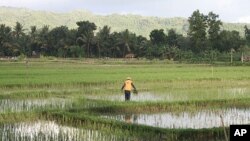Food issues are critical throughout Asia and involve a myriad of topics from agriculture and trade to health, hunger and infrastructure. On the eve of the ASEAN summit in Vietnam, discussions of rice are not prominent on the official agenda, if at all. Katsuji Matsunami of the Asian Development Bank explains how ASEAN can address rice production and distribution on a larger, regional scale.
Rice has long been a staple of Asian diets, but its trade has become a very political issue since rice prices soared in 2008. What can ASEAN nations do collectively to ensure enough rice remains available at affordable prices?
In many Asian countries, they call rice a political commodity rather than economic commodity. But to make this happen, rice productivity has to increase, so that we’ll have enough rice within the length of the area so that not large numbers of farmers would have to continue producing rice. For rice to become less political, we’ll have to work on other areas outside agriculture like trade where, when the price hike like 2008 happens, then the rice exporting countries put the export ban, and importing countries will, in desperation, buy rice at whatever the price is available. Then it would feed into further market volatility and price hikes, so on so forth. So I think there has to be a lot more work needed to be done on trade and also some regional activities like setting up the regional rice reserve, which ADB (Asian Development Bank) is working on within ASEAN+3 countries at the moment. So there is multi-sector aspects as needed. Also Asia is a major producer of rice and other grains, but increasingly, they are becoming importers. Rice has to become just one of other commodities in the longer run.
Will this topic be discussed heavily at the upcoming meetings?
We welcome ASEAN on rice issues, primarily on three things. Number one is trade. Can ASEAN+3 countries come to sit around the table and openly talk about the prospects of rice? Who might need rice? How much? And who might have marketable surpluses of rice? This kind of talk is not going on. These are all bilateral, government to government, and we are asking could it be possible to make it into the regional framework. And they say, “well, this is interesting, we could study this.” Similarly, there is a regional emergency rice reserve, and we are trying to set up implementation guidelines. At the moment, this regional rice reserve is purely for disasters.
Could Asian regional rice reserves be used for situations other than disasters?
These things require a lot more in-depth discussions among ASEAN+3 countries. Before we go out and say this could be this way we are going to do that, at the moment, we are trying to help them understand each other and see if we can come to some consensus about what we can do collectively. So at this moment, we are still working internally with ASEAN+3 countries, and us being able to go outside ASEAN+3 countries, and this is what we are going to do, takes a little more time.
Three Questions: ASEAN and Rice Production
